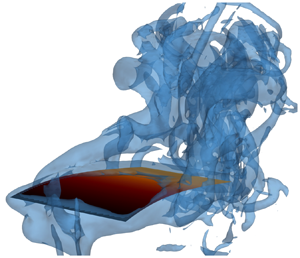Article contents
Effect of actuation method on hydrodynamics of elastic plates oscillating at resonance
Published online by Cambridge University Press: 08 January 2021
Abstract

In this work we investigate the effects of two distinct actuation methods on the hydrodynamics of elastic rectangular plates oscillating at resonance. Plates are driven by plunging motion at the root or actuated by a distributed internal bending moment at Reynolds numbers between 500 and 4000. The latter actuation method represents internally actuated smart materials and emulates the natural ability of swimming animals to continuously change their shapes with muscles. We conduct experiments with plunging elastic plates and piezoelectric plate actuators that are simulated using a fully coupled three-dimensional computational model based on the lattice Boltzmann method. After experimental validation the computational model is employed to probe plate hydrodynamics for a wide range of parameters, including large oscillation amplitudes which prompts nonlinear effects. The comparison between the two actuation methods reveals that, for the same level of tip deflection, externally actuated plates significantly outperform internally actuated plates in terms of thrust production and hydrodynamic efficiency. The reduced performance of internally actuated plates is associated with their suboptimal bending shapes which leads to a trailing edge geometry with enhanced vorticity generation and viscous dissipation. Furthermore, the difference in actuation methods impacts the inertia coefficient characterizing the plate oscillations, especially for large amplitudes. It is found that the inertia coefficient strongly depends on the tip deflection amplitude and the Reynolds number, and actuation method, especially for larger amplitudes.
JFM classification
- Type
- JFM Papers
- Information
- Copyright
- © The Author(s), 2021. Published by Cambridge University Press
References
REFERENCES
- 14
- Cited by



